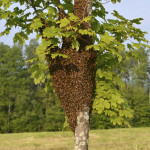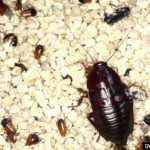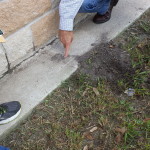 Since March 23, 2020, most TX schools have been closed due to the COVID-19 pandemic. However, during this time the most common pests of TX have not taken a break from your campuses. Even though our AgriLife Extension offices are closed we are still working from home and insect questions are still coming in. Over the past month we have seen an increase in stinging caterpillars mostly in the San Antonio and Hill county region of the state. There will be a special story on that coming later this week.
Since March 23, 2020, most TX schools have been closed due to the COVID-19 pandemic. However, during this time the most common pests of TX have not taken a break from your campuses. Even though our AgriLife Extension offices are closed we are still working from home and insect questions are still coming in. Over the past month we have seen an increase in stinging caterpillars mostly in the San Antonio and Hill county region of the state. There will be a special story on that coming later this week.
In the meantime, this is issue is to remind you of some of the important pests you need to consider and what you will need to do when schools open again in the fall.

A bee swarm consists of a queen bee surrounded by her colony of worker bees. Children and others should be warned to keep away from such swarms until it can be removed.
Honey bees (Apis mellifera) are swarming right now. What can schools do when they show up? According to our Entomologists you have three choices: 1) leave them be, 2) have a beekeeper pick them up, or 3) take them out with soapy water.
Wait aren’t bees protected? Why Kill Bees?
If you can’t find a beekeeper to remove them in a timely manner, extermination quickly eliminates any risks to kids, pets, or others of stings (instead of waiting 1-3 days for them to move) and reduces the chance that the swarm will enter and start nesting in a school building (an expensive problem). A little-known fact is that most wild bees are Africanized and not a good addition to a school campus. Also, wild (feral) honey bees are not endangered. Check out this article from Dr. Mike Merchant’s website on bees. https://citybugs.tamu.edu/factsheets/biting-stinging/bees/ent-3002/ Not sure where to find a local beekeeper then check out the Texas Apiary Inspection Service. You can find a list of beekeepers, by county, who may do removal in your area. https://txbeeinspection.tamu.edu/bee-removal/

Oriental cockroach (Blatta orientalis) Multiple Life Stages
The American Cockroach (Periplaneta Americana), Oriental cockroach,(Blatta orientalis) and the Smokybrown cockroach (Periplaneta fuliginosa) are common invaders of vacant structures. These “outdoor” cockroaches prefer warmer climates and moist surroundings and can thrive year-round in these conditions. The American cockroach is common in city sewers and basements, particularly around pipes and drains. The smokybrown prefers tree holes, loose bark, and mulch. The Oriental cockroach is common outdoors and lives in warm, damp shady areas near the ground or any area containing natural debris. Each species can build large populations if uncontrolled and can spread bacteria by contact. Finding them inside often indicates a need to pest-proof external entryways or looking into floor drains that may have not seen any water since early March. Ignoring these pests can be bad news when students and staff come back in August.
In TX, we have several species of bats, the most common one school IPM coordinators encounter is the Mexican free-tailed bat (Tadarida brasiliensis). The Mexican free-tailed bat, mate in the spring (now). Fertilization and fetal development follow, and pups are generally born in the late spring or early summer (mid-April to June). By late summer, the pups can fly and feed on their own. Which means if you have a colony of bats living in one of your school buildings the window to do exclusion work is about to close. However, maintenance staff need to be monitoring campuses for the occupation of bat colonies, identify where they are entering and exiting the structure. These areas will need to be sealed up in the fall in order to prevent the bats from returning to your campus building next year. Something to consider before you seal up the building for bats is to install a bat house close to the campus. Bats are creatures of habit and will return to the same roost year after year. Unfortunately, in the South, some bat species have found this area habitable all year long although their migration patterns may require them moving from one part of the state to another, they may not fully leave your buildings. So, the bat house is a way to allow them to have a safe place to live, but not occupy the building structure where people can be exposed to them.

Exterior inspections can help coordinators and pest management professionals find potential pest problems before them come inside.
Because fire ants (Solenopsis invicta) may present a hazard to children who are allergic to their venom, fire ant control should be made a top priority around athletic fields, playgrounds and classroom buildings. Emphasize year-round suppression of fire ant activity in landscapes in and around buildings because fire ant mounds are usually located outdoors. Fire ant baits provide excellent control and are considered a preferred treatment. Where fire ant mounds are not numerous, individual mounds may be treated with baits or contact insecticides according to label directions. Over the past month I have heard many districts are forgoing their spring treatments since no one is around. This is alarming because if you don’t treat now and again in the fall, the chances are this ant species will be a common visitor to all your outdoor fall events. Now is the time to put out your spring bait for fire ants. Visit our website dedicated to Red Imported Fire Ant to find treatment methods, how to calculate bait costs and must more.
Mosquitoes are of concern in the school environment because many species are painful biters and/or are capable of transmitting diseases. In the United States, the threat of developing encephalitis from mosquitoes is far greater than the threat from other mosquito vectored diseases. Encephalitis, meningitis and other diseases can develop from the bites of mosquitoes infected with certain viruses such as West Nile, St. Louis encephalitis, LaCrosse (California) encephalitis, and Eastern equine and Western equine encephalitis. An effective control program will not eliminate all mosquitoes but will keep the population at a reasonable level and will reduce both nuisances and the risk for mosquito-borne diseases.
While many rely on their local health departments to provide vector control in their area, the fact is most mosquito programs don’t come on school property. The focus of the vector control departments is to prevent mosquitoes via larviciding and then spraying products that kill the adults. Larviciding is the regular application of microbial or chemical insecticides to water bodies or water containers. The aim of larviciding is to reduce the adult population of mosquitoes by killing the aquatic immature forms, so that fewer will develop into adults. This is something every school district in TX should be considering as there are so many areas within our school districts that mosquitoes can breed and live. Again, this is something that if you tackle now you won’t have as many of these “friends” come fall. And by the way there are some cool mosquito traps that use a combination of larvicides and adulticides that can be placed around your campuses that work 24/7. Check out this story from last November on mosquito control in a California School.

Norway rats enjoying the French Quarter while the tourists are away.
Finally, this newsletter would not be complete without discussing the least desirable pests: mice and rats. If you have been watching the news or social media these critters have taken front stage in many urban areas. If you do nothing else while students and staff our out of your schools is to exclude or seal up as many entry points as possible. This is the perfect time to attack those areas that you normally don’t have time to do. In areas that you have had high populations make sure you are baiting as well. If you search for City of New Orleans and rodents, you will see what my friends are doing which is baiting heavily in areas that the rats are searching for food. Mice and rats are opportunistic, and they will eat anything even their young, but I have also seen them eat crayons, paper, or more than likely the food that the teacher left in their classroom back in March.
One last item before you go, our county agents have been reporting sightings of true armyworms in hay fields. I mention this as you will want your grounds people to be on the alert for fall armyworms later this year. Check out this newsletter posting from 2018 on this topic
Remember we have plenty of resources to help you out to establish those threshold levels or help you decide what options you have. Visit the School IPM Website for more information on the most common pests we see in schools.
I would like to thank the team of community entomologists: Dr. Mike Merchant, Dr. Robert Puckett, Dr. Sonja Swiger, Molly Keck and Wizzie Brown for helping me figure out what pests to feature. Remember we are all here to help you.

 .
.